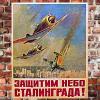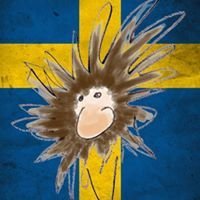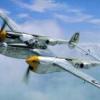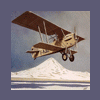Search the Community
Showing results for tags 'dornier'.
-
Article @ IPMS-Stockholm
-
Always had a fascination with the DO 335, one of the stranger aircraft to come out the war , but a personal favorite, am glad for the allies it didnt get any further than a few in service but it would have been hell of a interesting squardon if it made it to the war longer.Usual Tamyia top quality build quality ,please excuse the pictures taken from I phone for easy of up loading And a final one with my FW190D ,for size comparison .
-
The Dornier Do 26 was a result from a 1937 order from Deutsche Lufthansa for three long range flying boats, capable of operating non-stop in the Lisbon-New York route. The first prototype, D-AGNT Seeadler (Sea Eagle), made its first flight on 21 May, 1938, and the second one, D-AWDS Seefalke (Sea Falcon) was completed in the beginning of 1939. These were the only boats completed before the war, so the third prototype D-ASRA Seemöwe (Seagull) went to Luftwaffe together with 3 more aircraft. Both Seeadler and Seefalke never went into service in the North Atlantic route as planned, instead they made 18 South Atlantic crossings transporting mail before the war put an end to the service. You may look for more on the Do 26 in John Stroud's "European Transport Aircraft since 1910", 1966 Putnam, or in the article from the Wings Of Peace series by the same John Stroud published in Aeroplane Monthly, June 1988. As far as I know there are two vacform kits of the Do 26 1n 1/72 - Airmodel (OOP) and Combat Models (listed in their page). I suspect that they are the same, but I'm not sure. There is also the injected kit by Mach 2, and Amodel promises a new kit for later this year. I had the Airmodel kit on my stash for many years and recently I began cutting and sanding the parts, apart from a timid start. Here are the parts, together with the beautiful plans (from Flugsport magazine) printed in the back of the instructions: On thing I always do with vacforms - and also with some short run injected kits, with no locating pins - is to add some tabs, as it makes so much easier the build: It is also important to glue stretched sprue where you must have a sharp edge. After adding some putty, a gentle sanding with a sanding block gives you the knife edge difficult to obtain by the molding process. This is the basic cockpit interior. I intend to detail it much more, as I will open the roof and the front hatch. I'm glad it fits well! The center section parts together with a spar are also glued. And that's all for now. I hope to show some progress later this week. Carlos
- 8 replies
-
- Dornier
- Flying Boat
-
(and 2 more)
Tagged with:
-
Good afternoon colleagues. I want to show work, work old, machine guns bad Do18D K6+GK from 2/KuFlGr 306. North Sea, Island Zilt. there is a real photo of this board dated on October 22, 1939 this division was later is reformed and got a new number 3/KuFlGr 406. http://www.karopka.ru/showthread.php?t=7940 Model problems: 1 The model from itself represents a mix, something average between D and G modification. It should D and not to G. Main a model problem - a fuselage nose. Never D had it such stupid, not not at G. 2 Propellers - on model very much not true. They wide and a profile at them another. I had to do all propellers from scratch. 3 In a design of Do18 used a cloth. And in model imitation I sagged is on wheels. But this isn't enough… At least the wheel of the direction sagged cloths it is necessary to do most. On casting of it isn't present. Here main problems. Propellers OLD NEW
-

Dornier JIId Do 15 "Wal" Huma modell 1:72
EXPrompt posted a topic in Ready for Inspection - Aircraft
Good afternoon colleagues. The model is executed in an early camouflage of Luftwaffe and has still civil registration. D-AKEK, werk num.553, 1 (Mz. )/186 Bases List 1934-1936. On October 1, 1934 the first subdividing of sea scouts of Luftwaffe 1 (was created by Mz. )/186 . On which arms JIId "Wal" (Dо15) arrived. In 1936. This subdividing got new more recognizable number 2/KuFlGr.106. -
RA1 Watchkeeper ASTOR/AEW As austerity starts to bite, the Royal Air Force realise that it would be advantageous to combine roles and retire both the E3 and Sentinel aircraft. Their replacement - the Watchkeeper. This aircraft is equipped with synthetic apperture radar, airborne surveillance radar and an advanced optics suite. It is flown by a crew of 6: 2 pilots, 1 mission commander (and optical systems operator), battlefield radar mapping officer, airborne radar operator, and signals intel/electronic warfare officer. The crew are seated in comfort in "assisted exit" seats and the aircraft has an endurance of up to 14 hours before refuelling (or 20 with ferry pods attached) and a cruising speed of 300kts. It is capable of carrying stores on external hardpoints including fuel, electronic warfare pods, or - for targets of opportunity, a small number of offensive stores including bombs and missiles. The aircraft features a large moving map and a multiple integrated sensor suite - allowing the mission commander to make real time decisions on the battlefield. This is a fully integrated and multi capable ISTAR asset, using the latest computing and radar technology - truly a leap forward. The aircraft is expected to make its first flight late in 2013... Pictures of the prototype below.... Needless to say - this is really a spares box raider!!! Lots of filler, lots of bits and bobs and a bit of experimentation. I've tried to be as realistic as possible - still, for example, have to sort some cooling intakes for the radar systems.. Quite a bit of filling and sanding still to do, and quite a few aerials still to add (similar to those on top of the P8 Poseidon). I've scribed a door behind the seats in the cockpit, and there are 4 remaining glazed windows for the crew. Unfortunately, I managed to sand across one of them - any advice on how to make it right again happily received!!! It will be painted in a similar scheme to the RAF Sentinel, though I haven't decided what stores I'm going to place under the wings yet. It will use an F111 front gear, with a modified DO228 rear undercarriage with double wheels. Hope to finish this soon, but with 2 young children, a wife, and a busy real life flying schedule - watch this space.....!! Any comments, criticisms, and advice will be most welcome!
- 14 replies
-
- 1
-

-
- watchkeeper
- astor
- (and 6 more)
-
Dornier Do24 Flying Boat of the Dutch East Indies Pacific Crossroads 1:350 The Dornier Do 24 was designed to meet a Dutch navy requirement for a replacement of the Dornier Wals being used in the Dutch East Indies, with the Netherlands government signing a contract for six Dornier Do 24s on 3 August 1936. Two more prototypes were built for the German navy to be evaluated against the Blohm & Voss BV 138. The Do 24 was an all-metal parasol monoplane with a broad-beamed hull and stabilising sponsons. Twin tails were mounted on the upswept rear of the hull, while three wing-mounted tractor configuration engines powered the aircraft. Fuel was carried in tanks in the sponsons and the wing centre section. Up to 1,200 kg (2,600 lb) of bombs could be carried under the aircraft's wings, while defensive armament consisted of three gun turrets, one each in nose, dorsal and tail positions. In early aircraft the turrets were fitted with a single machine gun each, but later aircraft carried a 20 mm cannon in the dorsal turret. Do 24 V3, the first of the Dutch boats, took off from Lake Constance on 3 July 1937, with the second Dutch boat, Do 24 V4 following soon after. As the Dutch required that their flying boats use the same engines as the Martin 139 bombers in use in the Dutch East Indies, they were fitted with 887 hp (661 kW) Wright R-1820-F52 Cyclone radial engines. Test results were good, with the new flying boat proving capable of operating from extremely rough open seas, and the Dutch placed an order for a further 12 Do 24s on 22 July 1937. Do 24 V1, the first of the two aircraft for Germany, powered by three 600 hp (450 kW) Junkers Jumo 205C diesel engines, flew on 10 January 1938, but after evaluation, the two German boats were returned to Dornier for storage. The Netherlands was enthusiastic about the new flying boat, and planned to purchase as many as 90 Do 24s. Of these, 30 were to be built by Dornier (with all but the first two prototypes assembled by Dornier's Swiss subsidiary based at Altenrhein. The remaining aircraft were to be built under licence in the Netherlands by Aviolanda at Papendrecht. Of these aircraft, all but one of the German and Swiss built aircraft and the first seven Aviolanda-built aircraft were to be Do 24K-1s, powered by the original R-1820-F52 engines, while the remaining aircraft were to be Do 24K-2s, with more powerful 1,100 horsepower (820 kW) R-1820-G102 engines and more fuel. Thirty-seven Dutch- and German-built Do 24s had been sent to the East Indies by the time of the German occupation of the Netherlands in June 1940. Until the outbreak of war, these aircraft would have flown the tri-colour roundel. Later, to avoid confusion with British or French roundels, Dutch aircraft flew a black-bordered orange triangle insignia. A Dutch Dornier Do 24 is credited with sinking the Japanese destroyer Shinonome on December 17, 1941 while the ship was escorting an invasion fleet to Miri in British Borneo. On 10 January 1942 a Dutch Dornier Do 24K spotted a Japanese invasion fleet heading for Tarakan Island in Dutch Borneo, giving adequate warning so that all oil installations could be destroyed before the Japanese arrived. After the Japanese invasion of the Netherlands East Indies, six surviving Do.24s were transferred to the Royal Australian Air Force in February 1942. They served in the RAAF through most of 1944 as transports in New Guinea, making the Do.24 one of the few aircraft serving operationally on both sides during World War II. The Model This latest kit from Pacific Crossroads continues with the theme of materiel from the Dutch East Indies from 1941 to 1942. This time though, rather than a ship, they have released an important aircraft of the period, the Dornier Do24. The kit comes in a small, very sturdy cardboard box with a picture of a Do24 flying over one of the islands within the Dutch East Indies. As with the Admiralen destroyer kit there is a medal in the right hand corner of the picture. This one is the Dutch Flying Cross, the equivalent of the British Distinguished Flying Cross. On opening the box the modeller will see more polystyrene chips than kit. But digging them out there is a small bag of resin parts, which include the one piece fuselage, single piece wing and single piece tailplane and rudders. Only the tailplane is attached to a moulding block, with very fine attachments to the leading edge, which will be fairly easy to remove and clean up. The wing on the other hand, has several large, (relatively), pour stubs on the trailing edge, and these will be a little more difficult to remove without damaging the very thin edge. Great care and patience will need to be taken when cleaning up. The fuselage is very cleanly moulded, with just a small mould line on the starboard rear fuselage. The build, whilst simple, given the number of parts, may not be as easy as it looks. It will certainly be fiddly, with the interplane struts all produced in etched brass, which should be fitted to the fuselage and the glue allowed to set well before adding the wing. Five minute epoxy may be a better choice than CA for this kit. With the wing fitted, the tailplane can also be attached in addition to the support struts between the outer panels and the fuselage. Before fitting the propellers it is necessary to carefully remove the spinners first, attach the props then refit the spinners. Final detail parts included are the machine guns for the fore and aft turrets, the 20mm cannon for the dorsal turret, two aerial masts and a DF loop aerial. Decals The small decal sheet contains the orange and black triangles and rear fuselage bands for one colour scheme and the Dutch flag insignia for a second scheme. Unfortunately decals for the third scheme on the instruction sheet, that of an aircraft in Australian Air Force use is not included. There are no colour codes for the two schemes, so some research will be required to get them right. Conclusion Being a very different subject, particularly in this scale this is a great little kit and will look good in a diorama moored up in an island inlet or flying over the East Indies in support of a Dutch warship, it’ll only be up to the modellers’ imagination. However you use this kit, it’ll look great with a bit of care and attention. It’s certainly great to see Pacific Crossroads thinking outside the maritime box. Recommended. Review sample courtesy of
-
http://www.hannants.co.uk/product/AMU03672






